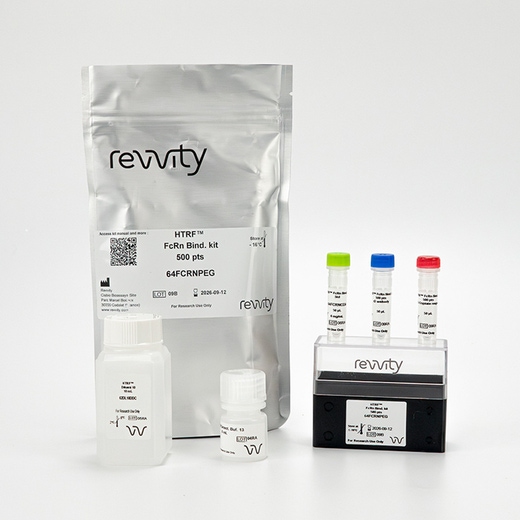

HTRF FcRn Binding kit, 100 Assay Points


HTRF FcRn Binding kit, 100 Assay Points






The FcRn binding kit is designed to monitor the binding of the IgG Fc region to the human FcRn receptor.
For research use only. Not for use in diagnostic procedures. All products to be used in accordance with applicable laws and regulations including without limitation, consumption and disposal requirements under European REACH regulations (EC 1907/2006).
| Feature | Specification |
|---|---|
| Application | Protein-Protein Interaction |
| Sample Volume | 10 µL |
The FcRn binding kit is designed to monitor the binding of the IgG Fc region to the human FcRn receptor.
For research use only. Not for use in diagnostic procedures. All products to be used in accordance with applicable laws and regulations including without limitation, consumption and disposal requirements under European REACH regulations (EC 1907/2006).



HTRF FcRn Binding kit, 100 Assay Points



HTRF FcRn Binding kit, 100 Assay Points



Product information
Overview
The neonatal Fc receptor is an Fc receptor found in the placenta. It displays the unique feature of facilitating IgG transport from the mother to the growing fetus. This receptor also has an important role in modulating IgG and albumin half-life in the bloodstream, influencing the pharmacokinetic parameters through an FcRn-mediated transcytosis process. The FcRn kit measures the binding between Fc-based molecules and the FcRn receptor.
Specifications
| Application |
Protein-Protein Interaction
|
|---|---|
| Brand |
HTRF
|
| Detection Modality |
HTRF
|
| Product Group |
Kit
|
| Sample Volume |
10 µL
|
| Shipping Conditions |
Shipped in Dry Ice
|
| Target Class |
Binding Assay
|
| Technology |
TR-FRET
|
| Therapeutic Area |
Inflammation
Neuroscience
Oncology & Inflammation
|
| Unit Size |
100 Assay Points
|
Video gallery

HTRF FcRn Binding kit, 100 Assay Points

HTRF FcRn Binding kit, 100 Assay Points

How it works
Assay principle
The FcRn receptor biochemical binding assay is a competitive assay involving the extracellular ectodomain of FcRn that is biotinylated and bound to Terbium cryptate-labeled Streptavidin, and human IgG1 labelled with d2. The unlabeled antibody or Fc fused drug competes with the d2 labelled IgG1 for binding to the receptor, resulting in a decrease in FRET signal.

Assay protocol
The FcRn biochemical binding assay needs only 1 incubation step after reagent distribution. Terbium Cryptate pre-labelled FcRn ectodomain is dispensed, followed by the addition of the sample and IgG1 labelled with d2. After 2h of incubation at RT, the signal can be read.

Assay validation
FcRn binding kit species selectivity
IgG1 isotypes from human and mouse were serially diluted with the diluent buffer provided in the kit, starting from 1mg/mL. Human and Mouse IgG1 were then tested in a competition mode. The chart demonstrates that the human IgG1 antibody efficiently displaces the d2 labelled IgG1 antibody in a dose dependent manner, whereas the FRET signal remains constant when the mouse IgG1 concentration increases. These data indicate that the FcRn binding kit is human IgG specific and not compatible with other IgG species.

Inhibitory effect of Rituximab and Pembrolizumab antibodies
The inhibitory effects of two FDA approved antibodies, anti-CD20 Rituximab and the anti-PD1 Pembrolizumab, were investigated with the FcRn binding kit. The anti-CD20 IgG1 Rituximab and the anti-PD1 IgG4 Pembrolizumab were serially diluted with the diluent buffer provided in the kit, starting from 1 mg/mL and tested in a competition dose response. The data presented in the graph show that both antibodies efficiently compete with the d2-labelled antibody in a dose-dependent manner, and display similar IC50. The results show that the kit is compatible with human IgG1 and IgG4 antibodies.

Resources
Are you looking for resources, click on the resource type to explore further.
Unlock the future of therapeutics with multispecific antibodies
Discover the groundbreaking advancements in multispecific antibody...


How can we help you?
We are here to answer your questions.






























